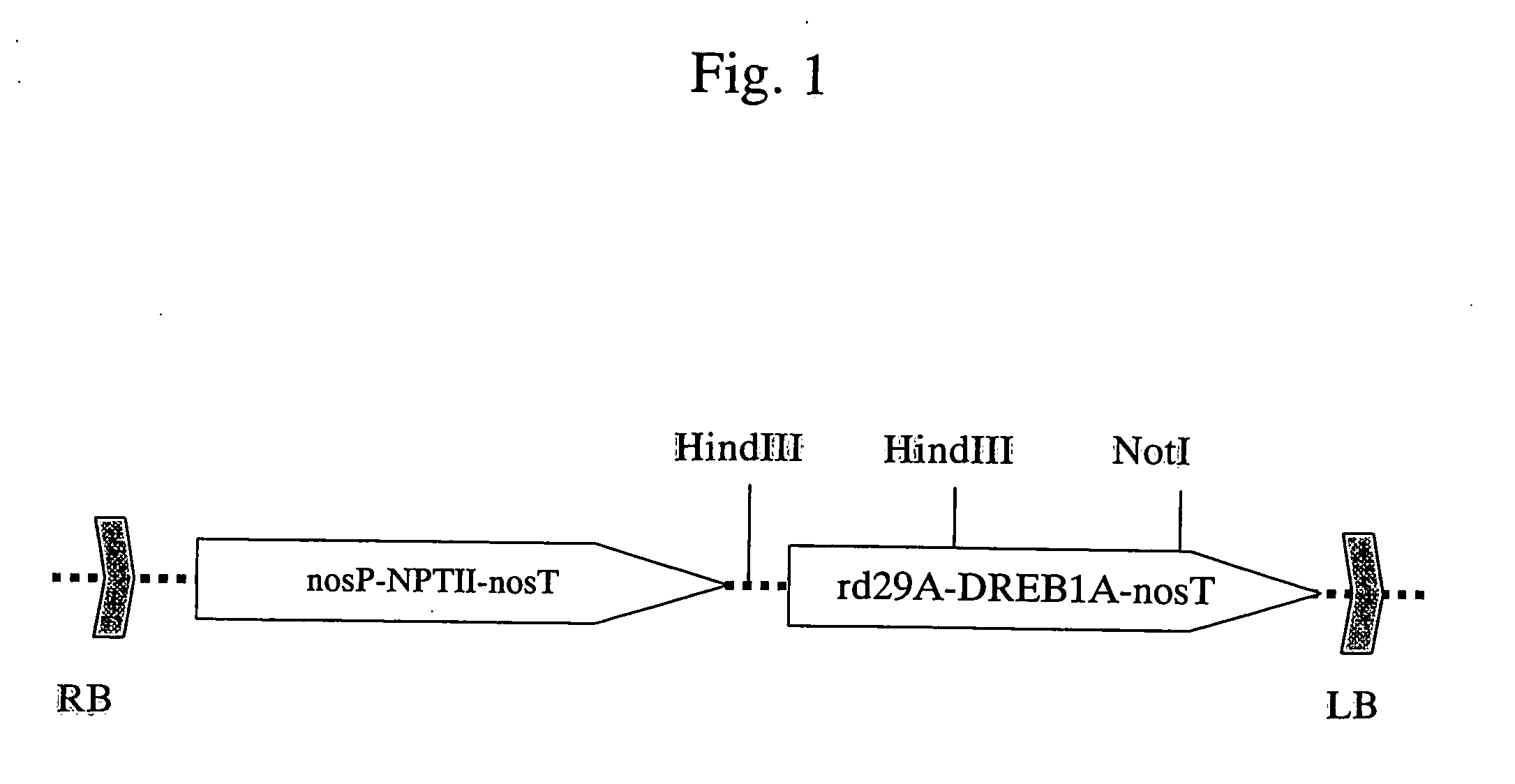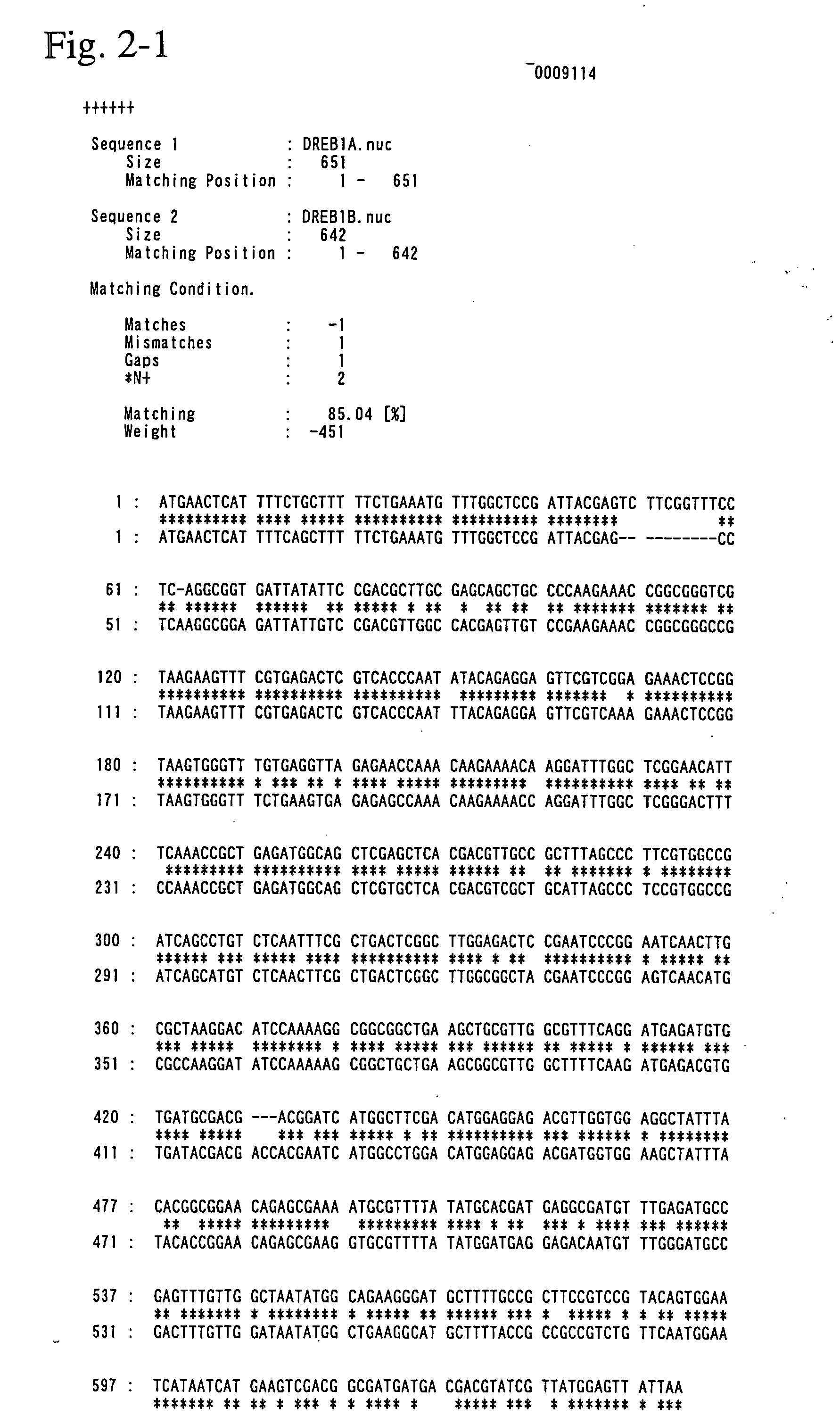Production of plants having improved rooting efficiency and vase life using stress-resistance gene
a technology of stress resistance and plant rooting efficiency, which is applied in the field of production of plants having improved rooting efficiency and vase life using stress resistance gene, can solve the problems of high cost, time consumption, and the vase life controlled by ethylene not being substantial improvement with regard to cut flowers, so as to prolong the vase life, enhance the rooting efficiency, and improve the rooting efficiency.
- Summary
- Abstract
- Description
- Claims
- Application Information
AI Technical Summary
Benefits of technology
Problems solved by technology
Method used
Image
Examples
example 1
Preparation of Chrysanthemum Plant Expressing DREB1a Gene
[0182] The rd29A-DREB1A expression vector described in Kasuga et al's report [Nature Biotech., 17 (1999) 287-291] is shown in FIG. 1. This vector was introduced into the Agrobacterium tumefaciens AGL0 strain by the electroporation method. The Agrobacterium tumefaciens AGL0 strain containing rd29A-DREB1A was inoculated into 3 ml of the following YEB-Km medium. After 16 hours of culture at 28° C. in the dark, cells were collected by centrifugation, and were then suspended in 10 ml of the following medium for infection. The suspension was used as a solution for infection. The medium compositions of the YEB-Km medium and the medium for infection are as follows.
[0183] YEB-Km medium: 5 g / l beef extract, 1 g / l yeast extract, 5 g / l peptone, 5 g / l sucrose, 2 mM magnesium sulfate (pH 7.2), and 50 mg / l kanamycin (Km)
[0184] Medium for infection: inorganic salt and vitamins in a half concentration of a MS [Murashige & Skoog, Physiol. Pl...
example 2
Salinity Tolerance Test
[0191] The apical buds that had developed 2 to 3 leaves of all the Lineker non-transformants and the Lineker transformants obtained in Example 1 were placed on the following growth media (in vitro) variously supplemented with 0.1, 0.2, and 0.4 M NaCl. Two weeks later, rooting was observed. With 0.2 M NaCl, rooting became unobservable in those buds to which no rd29A-DREB1A gene had been introduced, but rooting was observed in all of buds to which DREB gene had been introduced, excluding a line 14. Even with 0.4 M NaCl, rooting was observed in a line 9. The results for the non-transformants, and lines 9 and 10, are shown in Table 1.
[0192] Growth medium: MS medium with inorganic salt and vitamins, 30 g / l sucrose, and 5 mM MES (pH 5.8)
TABLE 1Salt tolerance testAdded salt concentration (M)Line No.00.10.20.49++++10+++−Non-transformant++−−
example 3
Propagation Using Scions and the Following Growth Test
[0193] The Lineker non-transformants and lines 9 and 10 of the Lineker transformants obtained in Example 1 were acclimatized in a greenhouse, thereby producing mother plants to obtain scions. Twenty scions were obtained from each line, planted in sufficiently-moistened soil for rooting (Akadama soil: Kanuma soil=1:1), covered with moisture-retaining covers having air permeability, and then cultivated within a greenhouse. Twenty-one days later, plants were harvested so as not to damage the roots from the soil for rooting, and then rooting conditions were observed. The plants were classified in descending order from high to low rooting levels (high, moderate, low, and none (no rooting was observed)), and the number of scions was recorded. The results are shown Table 2 below and in FIG. 10. Surprisingly, rooting ability was significantly improved in lines 9 and 10 to which the rd29A-DREB1A gene had been introduced, compared with th...
PUM
| Property | Measurement | Unit |
|---|---|---|
| temperatures | aaaaa | aaaaa |
| temperatures | aaaaa | aaaaa |
| temperatures | aaaaa | aaaaa |
Abstract
Description
Claims
Application Information
 Login to View More
Login to View More - R&D
- Intellectual Property
- Life Sciences
- Materials
- Tech Scout
- Unparalleled Data Quality
- Higher Quality Content
- 60% Fewer Hallucinations
Browse by: Latest US Patents, China's latest patents, Technical Efficacy Thesaurus, Application Domain, Technology Topic, Popular Technical Reports.
© 2025 PatSnap. All rights reserved.Legal|Privacy policy|Modern Slavery Act Transparency Statement|Sitemap|About US| Contact US: help@patsnap.com



